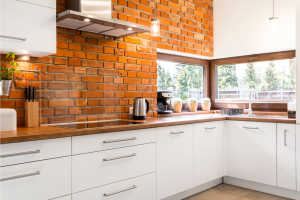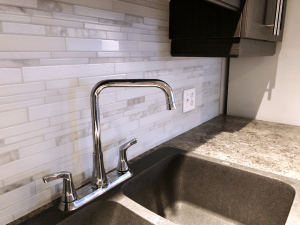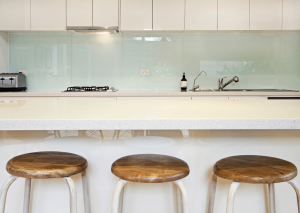Splashbacks are both a functional and decorative part of our kitchens that we all need. It’s easy for stains from cooking or water and bubbles from over-excited washing-up to splash against your kitchen walls, so choosing a material for your splashback that prevents this but also fits the aesthetic of your kitchen is integral. However, a splashback does not need to cover an entire wall and can be designed from nearly any material! We’ve put together a guide on the top materials to use for your kitchen splashbacks, here they are.
Open brick

If you designed your kitchen with a rustic theme, keeping the brickwork behind your hob, oven and sink can be a great way to create warmth. However open brick splashbacks need to have a coating of polyurethane sealant. This prevents the brickwork from crumbling over time as it becomes exposed to high temperatures or humidity, as well as giving a sleek matte or satin shine to the work, further enhancing the aesthetic. Bricks can be cut to give a seamless appearance so no need to worry about tight corners too.
Ceramic

A longstanding popular choice, ceramic tile splashbacks are both easy to clean and very heat resistant. Ceramic splashbacks can take a huge amount of wear and tear, so as it’s appearance will not change over time makes a great long-term investment! Particularly helpful for families with young children, especially if you’re letting them loose with cupcake mixtures. Ceramic tiles also come in pretty much any colour so they easily fit nearly any colour theme, so they’ll blend in well with your choice of cabinets and worktops.
Stainless Steel
Perfect for kitchens with a metallic or chrome feel, stainless steel is both easy to wipe down and can reflect the light back into the kitchen. Ironically stainless steel can easily become discoloured if you do not clean the splashback for prolonged periods of time, so keep on top of it. Stainless steel is also very heat resistant and durable so the natural accompaniment to a gas hob or stove. It can also be cut to your specifications. Using stainless steel as a splashback can also give your home a modern feel even.
Quartz Splashbacks
Quartz is the epitome of long-term investments when it comes to splashbacks due to its strong and durable properties. This makes Quartz heat and stain resistant, making cleaning so much easier. You won’t need to worry about much maintenance after installation, as Quartz is also non porous so aside from a wipe down when it becomes dirty, you won’t have to worry about the integrity of the Quartz eroding down over time.
Granite Splashbacks
Similarly to Quartz and other high quality stone splashbacks, a granite splashback can add a touch of superior quality to your kitchen. Aesthetically granite is a great choice for your kitchen splashback and can help seamlessly blend your worktops into your splashback. However, Granite is a porous stone. If you do not regularly clean and maintain a protective finish, granite can absorb oils and liquids which will compromise its integrity over time. It’s not all high risk though, as granite is very resistant to heat and stains providing it is well looked after.
Wood/Panel Splashbacks
Arguably one of the cheapest materials to install as a splashback, wooden splashbacks or wooden panel splashbacks complement modern and contemporary kitchens very well. As wood does not need to be grouted, this can really save you on installation costs as well as blend well with kitchen countertops. Their smooth surfaces prevent the build-up of grime and grease which is more present in tiled splashbacks. Like all splashbacks however, wooden splashbacks do have a downside in that they are less resistant to heat, and may need replacing more depending on the quality of the wood used.
Concrete Splashbacks
Perhaps not the first choice to come to mind, but you can actually do a lot with concrete splashbacks. First, you can add texture or style depending on how you allow the splashback to set. Frequently associated with modern styles, this works well for edgy or minimalist styles, as well as modern, art deco or vintage style kitchens. It’s also relatively inexpensive as you are not using this as grout to add tiles or other materials. Concrete does stain very easily so you may have to pay more attention to cleaning whilst cooking meals that are likely to spit.
Glass Splashbacks

Glass splashbacks are arguably one of the easiest splashbacks to maintain in that they are easily cleaned and can be incredibly heat resistant. One of the benefits here is that you have a huge amount of glass to choose from! Tempered glass is incredibly heat resistant, and less likely to break down over time due to its durable properties. You could also opt for stained glass allowing you to feature your own designs, chequered glass for texture or style, as well as other patterned glass styles. Glass also reflects a huge amount of natural light back off of your splashback, which can give the appearance of a larger kitchen space.
Acrylic Splashbacks
Particularly popular for art deco styles, acrylic splashbacks are very easy to maintain and can add a number of designs to your kitchen. Retro colours such as lime green, navy blue, deep reds are in demand, and because of the thickness of acrylic mean that it’s easily cleaned. What’s more, you can combine acrylic splashbacks with other styles of splashbacks such as glass to create a layered effect for your splashback and reflect light back over your chosen colour. This also works with PVC or you can find acrylic splashbacks with Perspex linings which make acrylic even more long lasting and durable. In terms of money saving, acrylic splashbacks are also very easy to install which can bring down the cost of installation and maintenance.
Have we inspired you to renovate your kitchen or upgrade your kitchen splashback? Call us today on 01535 653 530 or fill out our quick and easy online contact form.
